Granular Materials
In our everyday world, matter is usually classified into solids, liquids, and gases. But what about dry sand? It flows in an hourglass. It takes the shape of its container, as liquids do. One grain of sand is of course a solid, but a whole lot of grains together are a granular material, with quite different properties.
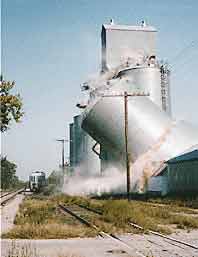
Collapse of a grain container (photo courtesy of Robert Behringer, Duke University)
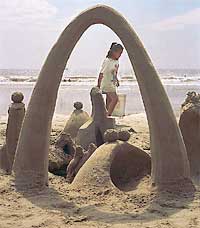
Sand arch (Sand sculpture and image by Larry Nelson)

This building in San Francisco sunk into the ground after the 1989 Loma Prieta earthquake. (photo courtesy of NASA)
The photo shows a group of sandpiles. If sand is poured slowly onto a surface, the pile will grow until its slope reaches a critical angle, determined by the size and stickiness of the grains. Beyond the critical angle, there is some sort of avalanche.
Many basic products, including a variety of building materials, chemicals, pharmaceuticals and food, are granular. Because of the properties of granular materials, many processing plants operate inefficiently and sometimes experience catastrophic failures, such as the collapsing grain container shown in the photo.
Wet sand can be formed into sandcastles and even, as shown in the photo, arches. But adding too much water weakens the sand, so it no longer can support itself. The next photo shows a building in the Marina District of San Francisco after the 1989 Loma Prieta earthquake. The shocks of the earthquake turned the wet soil to a liquid that no longer could support the building, which then sank into the ground.
Beyond their practical importance, granular materials interest physicists because they are an unusual form of matter with interesting properties that are not yet fully understood. The physics of granular materials is based on a few basic ideas:
- Gravity exerts a downward force on each particle.
- Friction between the particles depends on the size and nature of the particles and also on the medium between the particles, such as water.
- Much mechanical energy is lost to heat as the particles move (think of what happens to your kinetic energy when you jump on a beanbag chair).
Granular materials form what are called “collective” systems, because the particles’ touching and rubbing together is so important in determining what happens. In a sandpile, for instance, each particle touches only a few others, but these “short range” interactions determine what happens to the whole pile. In this sense, a sandpile could be a model for the behavior of, for example, cells in a colony or workers in an economy. The search for broad, general concepts that will help explain all collective systems is particularly appealing to physicists.
Research
As mentioned before, granular material can behave like a fluid, and in unexpected ways. For example, when a narrow tray of small spheres is shaken up and down, under certain conditions the spheres move up and down like a standing wave, as shown in the Caltech research group’s video and photo. Typically this fluidlike behavior appears at particular shaking frequencies and depths of particles.
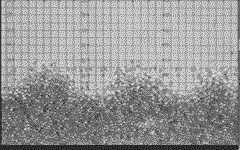
Wave formation in a layer of shaken particles; the vibration of the tray is sinusoidal at 20 cycles per second; the particles are glass spheres about 1 mm in diameter.
In a similar experiment, first performed at the University of Texas at Austin and then at Argonne National Laboratory, researchers shook a much wider tray, resulting in the hexagonal pattern shown in the photo. Much the same kind of shaking happens during earthquakes, and it can produce both solid and fluid behavior, even at the same time. The theoretical analysis that explains these results promises to be widely applicable to the motion of many different kinds of granular materials.
One of the most surprising findings was the existence of individual oscillations, which in fact make up the hexagonal pattern above. The photo, taken at the University of Texas at Austin, shows a single peak and valley, surrounded by an undisturbed surface of the metal spheres.
These examples show how in the laboratory, as well as in the everyday world, granular materials display a wealth of interesting phenomena. The physicists who study them produce fundamental research into the nature of matter, and since these materials figure so prominently in our economy, this research may make possible important applications as well.

Dynamic Hexagon Patterns: Vertically vibrated sand organizes itself in a perfect honeycomb state. (photo courtesy of Materials Science Division, Argonne National Laboratory)
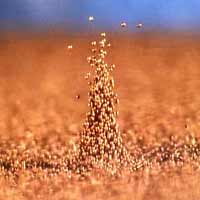
Single peak and valley in a tray of shaken metal spheres (photo courtesy of Paul Umbanhowar, Northwestern University)
Links
NASA
Caltech
The Why Files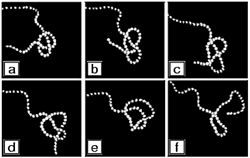
Shaking tray unties knot (image courtesy of Eli Ben-Naim, Los Alamos National Laboratory)















